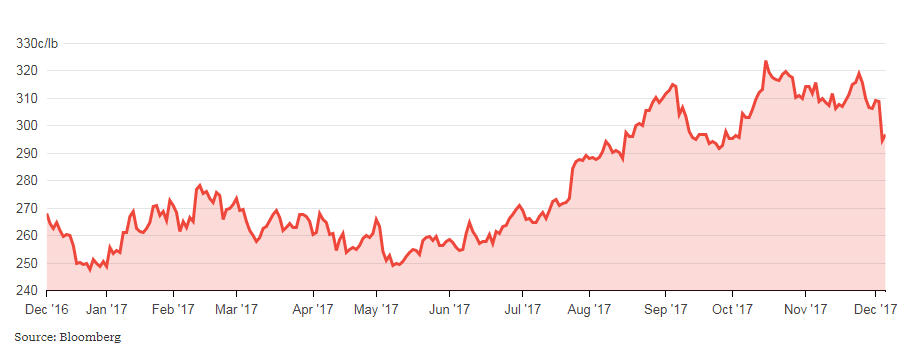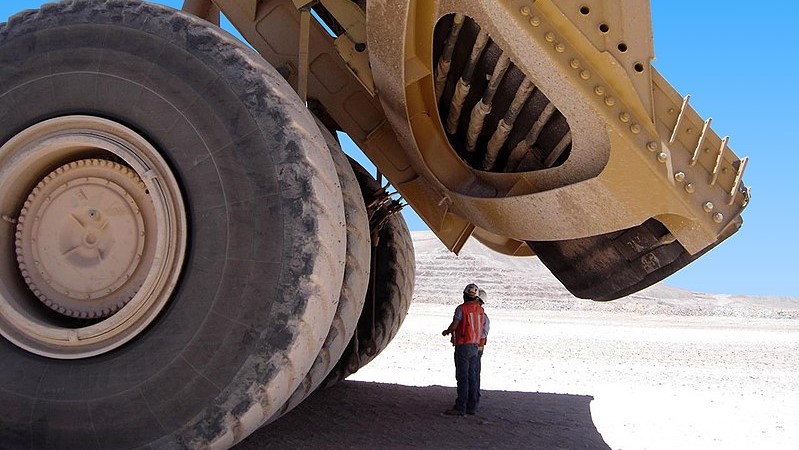Copper’s art of the deal

(Bloomberg) — The seeds of Tuesday’s 4.6 percent copper slump — the sharpest in almost three years — were planted in a scarcely noted non-event earlier this month.
Smelters and miners meeting during Asia Copper Week in Shanghai failed to come to an agreement over processing fees for 2018, and split without an agreement on a benchmark price, a smelter official with knowledge of the matter told Bloomberg News Friday.
Such miner-smelter agreements on treatment and refining charges, or TC/RCs, are an important indicator for the direction of the two industries we collectively call the copper market. Miners produce largely concentrates, a powdery brown intermediary product that’s then sold to smelter-refiners to turn into the pink metal itself. Just six of the world’s top 20 miners appear on the list of the world’s top 20 refiners.
Tarnished
Chicago copper futures put in their sharpest fall in almost three years Tuesday

As a result, although most miners make some refined copper cathode on the side (1), much of their information about demand from end-users still comes not through their own contacts, but from soundings with the smelters.
These talks follow a familiar pattern. If the supply of concentrates outpaces smelter capacity, TC/RCs rise as miners are forced to pay more to get their place in the queue. When concentrate supply is weak and smelting capacity strong — broadly speaking, the situation we’ve seen over the last two years or so — TC/RCs ought to fall.
Chinese treatment charges slid to a multi-year low of $75 a metric ton in March. (2) Miners appear to believe that something at that level or even lower will be merited over the year ahead, with the threat of industrial action rising at Latin American pits and Chinese smelters continuing to add capacity.
Smelters argue for keeping TCs flat at around $80 a ton or higher, based on worries that environmental regulations will slow the addition of new facilities while mining strikes fizzle out. That may sound self-serving, but it’s not impossible: The bulk of new Chinese capacity isn’t likely to be added until the fourth quarter of 2018, according to Bloomberg Intelligence analyst Yi Zhu.
That last point is worth pondering. The recent strength of prices has been based in part on the expectation that the bullish demand conditions seen in the run-up to the Chinese Communist Party’s congress in October will continue unbroken into 2018. If that’s the case, it’s strange Chinese smelters aren’t rushing to boost capacity to feed that beast. Putting off expansion is normally what you do when demand is looking soft, not strong.
If the International Copper Study Group is correct in its assessment that apparent usage in the People’s Republic edged down by about 1 percent this year, that would help explain why local processors are sticking to their guns. If you think concentrate supply from mines will pick up before your own capacity grows enough to push TC/RCs down, you’re not going to rush to accept a low price right now.
The increasing strength of the global economy suggests that copper’s rally in recent months does have some basis, but in the immediate term there are risks. China is about to go through its winter industrial lull, and traders believe a private investor has taken an excessively large long position in Shanghai contracts, according to Standard Chartered Plc analyst Nicholas Snowdon. Taking profits on such a substantial trade will be hard to accomplish without pushing the market lower, especially if other investors remain divided on the direction of prices.
When smelters and miners can’t come to an agreement, that should give even the most bullish investors reason to pause.
This column does not necessarily reflect the opinion of Bloomberg LP and its owners.
- The typical split is around 80 percent concentrates to 20 percent refined copper — although some miners, such as Lundin Mining Corp., produce concentrates exclusively.
- Refining charges are typically the same amount in cents per pound as treatment charges are in dollars per ton, so that a $75/ton TC would result in RCs of 75 cents/lb. As a result of that ratio, treatment charges generally make up about 60 percent of the overall TC/RC.
To contact the editor responsible for this story:
Katrina Nicholas at knicholas2@bloomberg.net
{{ commodity.name }}
{{ post.title }}
{{ post.date }}

Comments